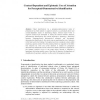Free Online Productivity Tools
i2Speak
i2Symbol
i2OCR
iTex2Img
iWeb2Print
iWeb2Shot
i2Type
iPdf2Split
iPdf2Merge
i2Bopomofo
i2Arabic
i2Style
i2Image
i2PDF
iLatex2Rtf
Sci2ools
CONTEXT
2005
Springer
2005
Springer
Context-Dependent and Epistemic Uses of Attention for Perceptual-Demonstrative Identification
Object identification via a perceptual-demonstrative mode of presentation has been studied in cognitive science as a particularly direct and context-dependent means of identifying objects. Several recent works in cognitive science have attempted to clarify the relation between attention, demonstrative identification and context exploration. Assuming a distinction between ‘(language-based) demonstrative reference’ and ‘perceptualdemonstrative identification’, this article aims at specifying the role of attention in the latter and in the linking of conceptual and non conceptual contents while exploring a spatial context. First, the analysis presents an argument to the effect that selection by overt and covert attention is needed for perceptualdemonstrative identification since overt/covert selective attention is required for the situated cognitive access to the target object. Second, it describes a hypothesis that makes explicit some of the roles of attention: the hypothesis of i...
| Added | 26 Jun 2010 |
| Updated | 26 Jun 2010 |
| Type | Conference |
| Year | 2005 |
| Where | CONTEXT |
| Authors | Nicolas J. Bullot |
Comments (0)

